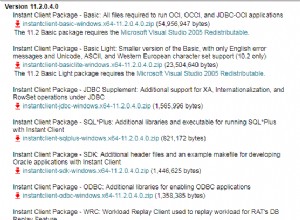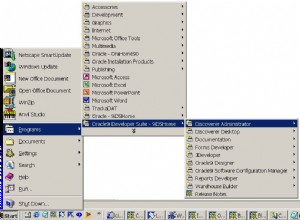
Inhaltsverzeichnis
Was sind gleichzeitige Manager
- Concurrent Manager sind die Controller der Hintergrundverarbeitung für Oracle-Anwendungen.
- Die Hauptfunktion von Concurrent Managern besteht darin, Prozessanfragen basierend auf einer Reihe von Regeln zu regulieren und zu kontrollieren.
- Es ist eine Technik, die verwendet wird, um nicht interaktive, datenabhängige Programme gleichzeitig im Hintergrund auszuführen.
- Oracle Applications wird mit vordefinierten Managern geliefert, einschließlich Internal Concurrent Manager (ICM), Standard Manager, Conflict Resolution Manager (CRM) und Transaction Managers (TM).
- Der Internal Concurrent Manager steuert alle anderen Concurrent Manager, die Betriebssystemprozesse sind, die Anfragen abfragen.
- Innerhalb von Anwendungen können Sie auch eine beliebige Anzahl von Concurrent Managern erstellen, um bestimmte Arten von Anfragen oder Programmen zu bearbeiten und sie für Ihre Geschäftsanforderungen zu spezialisieren
- Der ICM (Internal Concurrent Manager) steuert alle anderen Concurrent Manager.
- Der Standard-Manager akzeptiert alle Anfragen. Es hat keine vordefinierten Spezialisierungsregeln und ist die ganze Zeit aktiv. Es wird nicht empfohlen, dem Standardmanager Spezialisierungsregeln hinzuzufügen, da dies häufig zu Problemen führt.
- Der Conflict Resolution Manager löst Konflikte, wie z. B. Anforderungsinkompatibilitäten.
Concurrent Manager-Fehlerbehebung ist ein wichtiger Teil der Verwaltung von Oracle-Apps. Hier sind die 30 nützlichsten gleichzeitigen Manager-Abfragen, um Ihnen bei der Lösung von Problemen zu helfen. Melden Sie sich einfach mit geeigneten benutzerähnlichen Apps in der Oracle-Datenbank an, um alle Details zu erhalten
Die 30 nützlichsten gleichzeitigen Manager-Abfragen
Abfrage zur Überprüfung der Einstellung des ICM in der Concurrent Manager Umgebung
select 'PCP' "name", valuefrom apps.fnd_env_contextwhere variable_name ='APPLDCP' andconcurrent_process_id =(select max(concurrent_process_id)from apps.fnd_concurrent_processes where concurrent_queue_id =1)UNION ALLselect 'RAC' "name", decode(count( *), 0, 'N', 1, 'N', 'Y') "value" from V$threadUNION ALLselect 'GSM' "name", NVL(v.profile_option_value, 'N') "value" from apps. fnd_profile_options p, apps.fnd_profile_option_values vwhere p.profile_option_name ='CONC_GSM_ENABLED'and p.profile_option_id =v.profile_option_idUNION ALLselect name, value from apps.fnd_concurrent_queue_paramswhere queue_application_id =0 and concurrent_queue_id =1;
Abfrage, um die Details für alle aktivierten Concurrent Manager zu prüfen
select fcq.application_id "Anwendungs-ID",fcq.concurrent_queue_name, fcq.user_concurrent_queue_name "Service",fa.application_short_name, fcq.target_node "Node",fcq.max_processes "Target",fcq.node_name "Primary", fcq. node_name2 "Sekundär", fcq.cache_size "Cache-Größe", fcp.concurrent_processor_name "Programmbibliothek", sleep_secondsfrom apps.fnd_concurrent_queues_vl fcq, apps.fnd_application fa, apps.fnd_concurrent_processors fcpwhere fcq.application_id =fa.application_idund fcq.processor_application_id =fcp.application_idand fcq.concurrent_processor_id =fcp.concurrent_processor_id and fcq.enabled_flag='Y';
Überprüfen des Anforderungstyps und der Programme für die gleichzeitigen Manager
Spalte Aktionsformat a10Spalte Managerformat a20Spalte Objektformat a20Spalte Typformat a10Seiten festlegen 0Zeilen festlegen 400select q.application_id, q.concurrent_queue_name,q.user_concurrent_queue_name "Manager", l1.bedeutet "Aktion",l2.bedeutet "Typ", p .user_concurrent_program_name "Objekt" von apps.fnd_concurrent_queue_content c, apps.fnd_concurrent_queues_vl q, apps.fnd_concurrent_programs_vl p, apps.fnd_lookups l1, apps.fnd_lookups l2wobei q.concurrent_queue_id =c.concurrent_queue_idand q.application_id =c.queue_application_code =c.type_idand c.type_id 'und c.type_id =p.concurrent_program_idand c.type_application_id =p.application_idand l1.lookup_code =c.include_flagand l1.lookup_type ='INCLUDE_EXCLUDE'and l2.lookup_code ='P' und l2.lookup_type ='CP_SPECIAL_RULES'UNION ALLselect q. application_id, q.concurrent_queue_name,q.user_concurrent_queue_name "Manager", l1.bedeutet "Aktion", "Anwendung" "Typ", a.application_name "Objekt" aus apps.fnd_concurrent_queue_content c, apps.fnd_concu rrent_queues_vl q,apps.fnd_application_vl a, apps.fnd_lookups l1where q.concurrent_queue_id =c.concurrent_queue_idand q.application_id =c.queue_application_idand c.type_code ='P'and c.type_id is nulland c.type_application_id =a.application_idand l1.lookup_code =c.include_flagand l1.lookup_type ='INCLUDE_EXCLUDE'UNION ALLselect q.application_id, q.concurrent_queue_name,q.user_concurrent_queue_name "Manager", l1.bedeutet "Aktion",l2.bedeutet "Typ", x.complex_rule_name "Objekt"aus Apps. fnd_concurrent_queue_content c, apps.fnd_concurrent_queues_vl q,apps.fnd_concurrent_complex_rules x,apps.fnd_lookups l1, apps.fnd_lookups l2wobei q.concurrent_queue_id =c.concurrent_queue_idand q.application_id =c.queue_application_idand c.type_code ='C'and c.type_id =x. complex_rule_idand c.type_application_id =x.application_idand l1.lookup_code =c.include_flag and l1.lookup_type ='INCLUDE_EXCLUDE'and l2.lookup_code ='C'and l2.lookup_type ='CP_SPECIAL_RULES'UNION ALLselect q.application_id, q .concurrent_queue_name,q.user_concurrent_queue_name "Manager", l1.bedeutet "Aktion", l2.bedeutet "Typ", r.request_class_name "Objekt"aus apps.fnd_concurrent_queue_content c, apps.fnd_concurrent_queues_vl q, apps.fnd_concurrent_request_class r,apps.fnd_lookups l1 , apps.fnd_lookups l2where q.concurrent_queue_id =c.concurrent_queue_idand q.application_id =c.queue_application_idand c.type_code ='R'and c.type_id =r.request_class_idand c.type_application_id =r.application_idand l1.lookup_code =c.include_flag and l1 .lookup_type ='INCLUDE_EXCLUDE'and l2.lookup_code ='R'and l2.lookup_type ='CP_SPECIAL_RULES'UNION ALLselect q.application_id, q.concurrent_queue_name,q.user_concurrent_queue_name "Manager", l1.bedeutung "Aktion", l2.bedeutung " Type", o.oracle_username "Object"from apps.fnd_concurrent_queue_content c, apps.fnd_concurrent_queues_vl q, apps.fnd_oracle_userid o,apps.fnd_lookups l1, apps.fnd_lookups l2wobei q.concurrent_queue_id =c.concurrent_queue_idund q.application_id =c.queue _application_idand c.type_code ='O'and c.type_id =o.oracle_idand l1.lookup_code =c.include_flag and l1.lookup_type ='INCLUDE_EXCLUDE'and l2.lookup_code ='O'and l2.lookup_type ='CP_SPECIAL_RULES'UNION ALLselect q .application_id, q.concurrent_queue_name,q.user_concurrent_queue_name "Manager", l1.bedeutet "Aktion", l2.bedeutet "Typ", u.user_name "Object"from apps.fnd_concurrent_queue_content c, apps.fnd_concurrent_queues_vl q, apps.FND_OAM_FNDUSER_VL u, apps.fnd_lookups l1, apps.fnd_lookups l2wobei q.concurrent_queue_id =c.concurrent_queue_idand q.application_id =c.queue_application_idand c.type_code ='U'und c.type_id =u.user_idand l1.lookup_code =c.include_flag und l1.lookup_type ='INCLUDE_EXCLUDE'und l2.lookup_code ='U'und l2.lookup_type ='CP_SPECIAL_RULES'UNION ALLselect q.application_id, q.concurrent_queue_name,q.user_concurrent_queue_name "Manager", l1.bedeutet "Aktion", l2.bedeutet "Typ", to_char(c.type_id) "Objekt" aus apps.fnd_concurrent_queue_content c, apps.fnd_concur rent_queues_vl q,apps.fnd_lookups l1, apps.fnd_lookups l2where q.concurrent_queue_id =c.concurrent_queue_idand q.application_id =c.queue_application_idand c.type_code not in ('C','P','O','R', 'U ') und l1.lookup_code =c.include_flag und l1.lookup_type ='INCLUDE_EXCLUDE'und l2.lookup_code =c.type_code und l2.lookup_type ='CP_SPECIAL_RULES'; Überprüfen/Finden der Schicht/Max/Min für alle gleichzeitigen Manager
select fcq.application_id,fcq.concurrent_queue_name,fcq.user_concurrent_queue_name,ftp.application_id,ftp.concurrent_time_period_name,fa.application_short_name,ftp.description,fcqs.min_processes,fcqs.max_processes,fcqs.sleep_seconds,fcqs.service_parametersfrom apps.fnd_concurrent_queues fcq,apps.fnd_concurrent_queue_size fcqs,apps.fnd_concurrent_time_periods ftp,apps.fnd_application fawhere fcq.application_id =fcqs.queue_application_idand fcq.concurrent_queue_id =fcqs.concurrent_queue_idand fcqs.period_application_id =ftp.application_idand fcqs.concurrent_time_period_id =ftp.concurrent_time_period_idand ftp.application_id =fa. Anwendungs-ID;
Abfrage zum Überprüfen aller Werte der gleichzeitigen Manager-bezogenen Profiloption auf Site-Ebene und der dortigen Suche
SELECT fpo.profile_option_name,fpo.profile_option_id,fpov.profile_option_value,fpov.level_id,fa.application_short_name,fpo.user_profile_option_name,fpo.sql_validation,fpo.descriptionFROM apps.FND_PROFILE_OPTIONS_VL fpo,apps.FND_PROFILE_OPTION_VALUES fpov,apps.fnd_application fawhere fpo .application_id =0and fpo.site_enabled_flag ='Y'and (fpo.profile_option_name like 'CONC_%'or fpo.profile_option_name like 'FS_%'or fpo.profile_option_name like 'PRINTER%'or fpo.profile_option_name in ('EDITOR_CHAR', ' FNDCPVWR_FONT_SIZE', 'MAX_PAGE_LENGTH', 'APPLWRK')) und fpo.profile_option_id =fpov.profile_option_idand fpo.application_id =fpov.application_idand fpo.application_id =fa.application_idand fpov.level_id =10001; Abfrage, um den gleichzeitigen Managerstatus vom Backend zu prüfen
select q.user_concurrent_queue_name service_name,a.application_name srvc_app_name,a.application_short_name srvc_app_short_name,q.concurrent_queue_name service_short_name,decode( ( select count(*)from apps.fnd_concurrent_processes fcp1where fcp1.concurrent_queue_id =q.concurrent_queue_idand fcp1.queue.queue.queue application_idand (fcp1.process_status_code in ('C','M')or ( fcp1.process_status_code in ('A', 'D', 'T')und existiert (select 1from gv$sessionwhere fcp1.session_id =audsid ))) )/*actual_processes */, 0, decode(q.max_processes, 0,'NOT_STARTED', 'DOWN'),q.max_processes, 'UP', 'WARNING' ) service_status,q.max_processes target_processes,(select count(* ) from apps.fnd_concurrent_processes fcp2where fcp2.concurrent_queue_id =q.concurrent_queue_idand fcp2.queue_application_id =q.application_idand ( fcp2.process_status_code in ('C','M') /* Connecting or Migration */or ( fcp2.process_status_code in ('A ', 'D', 'T') und existiert (wählen Sie 1 aus gv$sessionwhere fcp2.session_id =au dsid)))) actual_processes,'' message, s.service_handle srvc_handlefrom apps.fnd_concurrent_queues_vl q, apps.fnd_application_vl a,apps.fnd_cp_services swhere q.application_id =a.application_idand s.service_id =q.manager_typeUNION/* Muss den Fall abdecken wobei ein Manager keine Zeilen in FND_CONCURRENT_PROCESSES hat. Äußere Verbindungen werden es nicht schneiden. */select q.user_concurrent_queue_name service_name,a.application_name srvc_app_name,a.application_short_name srvc_app_short_name,q.concurrent_queue_name srvc_short_name,decode( q.max_processes, 0, 'NOT_STARTED', 'DOWN') service_status,q.max_processes target_processes,0 actual_processes,' ' Nachricht, s.service_handle srvc_handlefrom apps.fnd_concurrent_queues_vl q, apps.fnd_application_vl a,apps.fnd_cp_services swhere q.application_id =a.application_idand s.service_id =q.manager_typeund nicht vorhanden (select 1from apps.fnd_concurrent_processes pwhere process_status_code in ('C' ,'M','A','D','T') und q.concurrent_queue_id =p.concurrent_queue_idund q.application_id =p.queue_application_id); Zum Überprüfen aller laufenden Jobs mit DB-Sitzungsdetails auf dem aktuellen DB-Knoten
Zeilen festlegen 200Seiten festlegen 200Spalte PHASE-Überschrift 'Phase'-Format A8Spalte STATUS-Überschrift 'Status'-Format A8Spalte PROGRAM-Überschrift 'Programmname'-Format A25Spalte REQUESTOR-Überschrift 'Anforderer'-Format A9Spalte START_TIME-Überschrift 'Startzeit'-Format A15Spalte RUN_TIME linke Überschrift ausrichten ' Runtime(m)' Format 9999.99Spalte OSPID Überschrift 'OSPID' Format a5Spalte SID Überschrift 'DBSID' Format 99999spool crrunning.lstselect fcrv.request_id REQUEST,decode(fcrv.phase_code,'P','Pending','R','Running ','I','Inactive','Completed')PHASE,decode(fcrv.status_code, 'A','Waiting', 'B','Resuming', 'C','Normal', 'F', „Geplant“, „G“, „Warnung“, „H“, „Halten“, „I“, „Normal“, „M“, „Kein Manager“, „Q“, „Standby“, „R“, 'Normal', 'S', 'Angehalten', 'T', 'Beenden', 'U', 'Deaktiviert', 'W', 'Pausiert', 'X', 'Beendet', 'Z', 'Wartend' ',fcrv.status_code)STATUS,substr(fcrv.program,1,25)PROGRAM,substr(fcrv.requestor,1,9)REQUESTOR,to_char(fcrv.actual_start_date,'MM/DD/RR HH24:MI')START_TIME ,round(((sysdate - fcrv.actual_start_date)*1440) ,2)RUN_TIME,substr(fcr.oracle_process_id,1,7)OSPID,vs.sid SID--substr(fcr.os_process_id,1,7)OS_PIDfrom apps.fnd_conc_req_summary_v fcrv,apps.fnd_concurrent_requests fcr,v$session vs,v $process vpwhere fcrv.phase_code ='R'and fcrv.request_id =fcr.request_idand fcr.oracle_process_id =vp.spidand vs.paddr =vp.addrorder by PHASE, STATUS, REQUEST desc/
So finden Sie die Ablaufverfolgungsdatei für eine bestimmte gleichzeitige Anfragest
Spalte Traceid-Format a8Spalte Tracename-Format a80Spalte user_concurrent_program_name Format a40Spalte execname-Format a15Spalte enable_trace-Format a12set Zeilen 80set Seiten 22set Kopf offSELECT 'Request id:'||request_id ,'Trace id:'||oracle_Process_id,'Trace Flag:'|| req.enable_trace,'Trace Name:'||dest.value||'/'||lower(dbnm.value)||'_ora_'||oracle_process_id||'.trc','Prog. Name:'||prog.user_concurrent_program_name,'Dateiname:'||execname.execution_file_name|| execname.subroutine_name ,'Status :'||decode(phase_code,'R','Running')||'-'||decode(status_code,'R','Normal'),'SID Serial:'||ses .sid||','|| ses.serial#,'Module :'||ses.modulefrom apps.fnd_concurrent_requests req, v$session ses, v$process proc,v$parameter dest, v$parameter dbnm, apps.fnd_concurrent_programs_vl prog,apps.fnd_executables execnamewhere req. request_id =&requestand req.oracle_process_id=proc.spid(+)and proc.addr =ses.paddr(+)and dest.name='user_dump_dest'and dbnm.name='db_name'and req.concurrent_program_id =prog.concurrent_program_idand req. program_application_id =prog.application_idand prog.application_id =execname.application_idand prog.executable_id=execname.executable_id;
Um die Gesamtaktivität des Request-Sets und seine verschiedenen Request-Erledigungszeiten zu finden
set linesize 300col "Program Name" format a50col Elapsed format 9999.99col "Process ID" format a10col REQUEST_DATE format a15col ACTUAL_START_DATE format a15col REQUEST format 999999999col PARENT format 999999999col argument_text format a50SELECT /*+ ORDERED USE_NL(x fcr fcp/ fcpt)* fcr.request_id "REQUEST", fcr.parent_request_id "PARENT",fcr.oracle_process_id "Prozess-ID",fcptl.user_concurrent_program_name "Programmname",fcr.argument_text,DECODE(fcr.phase_code,'X', 'Beendet','E ', 'Error','C','Completed','P','Pending','R','Running',phase_code) "Phase",DECODE(fcr.status_code,'X','Beendet', 'C', 'Normal', 'D', 'Abgebrochen', 'E', 'Fehler', 'G', 'Warnung', 'Q', 'Geplant', 'R', 'Normal', 'W ','Pausiert','Nicht sicher') "Status",--fcr.phase_code,--fcr.status_code,fcr.request_date,fcr.actual_start_date,fcr.actual_completion_date,(fcr.actual_completion_date - fcr.actual_start_date)*1440 "Elapsed"FROM (SELECT /*+ index (fcr1 FND_CONCURRENT_REQUESTS_N3) */fcr1.request_idFROM fnd_concurrent_requests fcr1W HIER 1=1START WITH fcr1.request_id =&request_id--CONNECT BY PRIOR fcr1.parent_request_id =fcr1.request_id) x,CONNECT BY PRIOR fcr1.request_id =fcr1.parent_request_id) x,fnd_concurrent_requests fcr,fnd_concurrent_programs fcp,fnd_concurrent_programs_tl fcrquest_id.WHEREquest_id) x.request_idAND fcr.concurrent_program_id =fcp.concurrent_program_idAND fcr.program_application_id =fcp.application_idAND fcp.application_id =fcptl.application_idAND fcp.concurrent_program_id =fcptl.concurrent_program_idAND fcptl.LANGUAGE ='US'ORDER BY 1
T o finden Sie die Sid aus der Anfrage-ID
select s.inst_id, fcr.request_id, fv.requestor, fv.Program cmgr_job,p.PID,p.SERIAL#,p.USERNAME p_user,p.SPID,to_char(s.logon_time,'DD-MON- YY HH24:MI:SS') Logon_Time,s.program,s.command,s.sid,s.serial#,s.username,s.process,s.machine,s.action,s.modulefrom apps.fnd_concurrent_requests fcr ,apps.FND_CONC_REQ_SUMMARY_V fv,gv$session s,gv$process pwhere fcr.request_id =&request_idand p.SPID =fcr.oracle_process_idand s.process =fcr.OS_PROCESS_IDand s.inst_id =p.inst_idand p.addr =s.paddrand fv. Anfrage_ID =fcr.Anfrage_ID;
Um alle Dinge im Detail von der bestimmten Anfrage-ID/Abfrage zu finden, um Details zu gleichzeitigen Anfragen zu finden/wie man den Status gleichzeitiger Anfragen vom Backend überprüft/Abfrage, um gleichzeitige Programmlaufzeit zu finden
Seiten festlegen 100;col request_class_application_id Format 99999999 Überschrift „REQUEST_CLASS|APP_ID“col os_process_id Format a8col application_short_name Format a5col request_start_date Format a18 Überschrift „REQUEST DATE“col actual_start_date Format a18 Überschrift „START DATE“col actual_completion_date Format a18 Überschrift „COMPLETE DATE“ --select r.REQUEST_ID,u.user_name, decode(r.PHASE_CODE,'C', 'Complete','P', 'Pending', 'R', 'Running', r.PHASE_CODE) phase,decode(r .STATUS_CODE, 'C', 'Normal', 'I' , 'Normal', 'R' , 'Normal', 'Q', 'Standby', 'E' , 'Fehler', 'X' , 'Beendet' ,'W', 'Pausiert' , r.STATUS_CODE) status,r.PRIORITY,decode(r.HOLD_FLAG,'N','"NOT on hold"','Y','"ON HOLD"',r. HOLD_FLAG) Hold_flag, p.application_short_name,f.user_concurrent_program_name,f.concurrent_program_name,e.EXECUTABLE_NAME,e.EXECUTION_FILE_NAME,e.EXECUTION_METHOD_CODE,e.EXECUTION_FILE_PATH, v.RESPONSIBILITY_name, r.REQUEST_CLASS_APPLICATION_ID, q.request_class_name, r.PARAMETER_REQUEST r.REQUESTED_START_DATE, TT-MO N-JJJJ HH:MI') request_start_date,to_char(r.ACTUAL_START_DATE,'DD-MON-YYYY HH:MI') actual_start_date,decode(r.ACTUAL_COMPLETION_DATE,null,'"Läuft noch"',to_char(r.ACTUAL_COMPLETION_DATE, 'DD-MON-YYYY HH:MI')) actual_completion_date,to_char(decode(r.ACTUAL_COMPLETION_DATE,null,SYSDATE,r.ACTUAL_COMPLETION_DATE)-decode(r.ACTUAL_START_DATE,null,SYSDATE,r.ACTUAL_START_DATE),'MI') "Laufende Zeit",r.CPU_SECONDS,r.LOGICAL_IOS,r.PHYSICAL_IOS,r.ORACLE_PROCESS_ID,r.ORACLE_SESSION_ID,r.OS_PROCESS_ID,r.CD_ID,decode(r.ENABLE_TRACE,'N', '"NOT Tracing"', 'Y', '"TRACING"', r.ENABLE_TRACE) Trace,decode(f.run_alone_flag, 'N', '"NOT Alone"', 'Y', ''RUN ALONE"', f.run_alone_flag) Allein, r.ARGUMENT_TEXT Parameter,r.LOGFILE_NAMEfrom fnd_concurrent_requests r, fnd_user u, fnd_application p, fnd_concurrent_programs_vl f, fnd_EXECUTABLEs e, fnd_responsibility_vl v, fnd_concurrent_request_class qwhere u.user_id =r.requested_byand p.application_id =r.PROGRAM_ID_APPLICATION und r.PROGRRID_APPLICATION RRENT_PROGRAM_IDund f.EXECUTABLE_ID=e.EXECUTABLE_IDund v.responsibility_id =r.responsibility_idund q.request_class_id (+)=r.concurrent_request_class_idund r.request_id =&reqid;
Sql, um ausstehende Anfragen in allen gleichzeitigen Managern zu finden/Abfrage, um ausstehende gleichzeitige Anfragen zu finden
select request_id,b.user_concurrent_queue_namefrom apps.fnd_concurrent_worker_requests a,apps.fnd_concurrent_queues_vl bwhere a.phase_code ='P'and a.status_code ='I'and a.hold_flag !='Y'and a.requested_start_date <=sysdateand a .concurrent_queue_id =b.concurrent_queue_idand a.control_code is null--and a.concurrent_queue_name !='FNDCRM'and a.concurrent_queue_name not in ('FNDCRM')order byrequest_id, b.user_concurrent_queue_name/ So finden Sie heraus, welcher Manager Ihre Anforderungs-ID/Abfrage ausführt, um einen gleichzeitigen Manager für ein gleichzeitiges Programmm zu finden
Spalte OsId Format A7Spalte Oracle_Process_ID Format 99999Spalte Concurrent_Queue_Name Format A20Spalte Log Format A25Spalte Started_At Format A20Set Head OffSet Verify OffSet Echo OffSelect'The ' || Concurrent_Queue_Name ||' Concurrent Manager hat Ihre Anfrage von',to_char(Actual_Start_date, ' MON-DD-YY HH:MI:SS AM') ausgeführt || ' - bis - ' ||to_char(Actual_COMPLETION_date, 'MON-DD-YY HH:MI:SS AM'),'The ' || Concurrent_Queue_Name ||' Concurrent-Manager-Protokolldatei ist ' || P.Logfile_Name,'Anforderungsprotokolldatei ist ' || R.Logfile_NameFrom Fnd_Concurrent_Queues Q,Fnd_Concurrent_requests R,Fnd_Concurrent_Processes PWhere(P.Concurrent_Queue_ID =Q.Concurrent_Queue_ID AndQueue_Application_ID =Q.Application_ID )Und R.Controlling_Manager =P.Concurrent_Process_IDAnd R.Phase_Code ='C'And Request_ID =&Request_ID; vor>So finden Sie den Verlauf des Request-ID-Programms
set linesize 250col Format Anfrage_Datum a15col Format Anfrage_Startdatum a15col Format aktuelles_Startdatum a15col Format aktuelles_Abschlussdatum a15col Format Argument_Text a70col Format Elapsed 9999.99select * from (select a.request_id, a.parent_request_id,DECODE(a.phase_code,'C','Completed' ,'I','Inactive','P','Pending','R','Running') || ' ' ||DECODE(a.status_code,'A','Waiting','B',' Resuming','C','Normal','D','Cancelled','E','Error','G','Warning','H','On Hold','I',' Normal ','M','Kein Manager','P','Geplant','Q','Standby','R','Normal','S','Unterbrochen','T','Beendet' ,'U','Deaktiviert','W','Pausiert','X','Beendet','Z','Wartend') "PHASE_STATUS ", a.request_date, a.requested_start_date, a.actual_start_date, a .actual_completion_date ,(nvl(actual_completion_date,sysdate) - actual_start_date)*1440 "Elapsed", a.argument_text ,a.USER_CONCURRENT_PROGRAM_NAMEfrom apps.FND_CONC_REQ_SUMMARY_V a where a.concurrent_program_id=(select concurrent_program_id from fnd_concurrent_requests where reque st_id=&1)---(nvl(actual_completion_date,sysdate) - actual_start_date)*1440> 10order by a.request_id desc) where rownum <100;Abfrage zum Prüfen des Verlaufs gleichzeitiger Programmausführungen
ttitle offset linesize 180set pagesize 60set newpage 0set pause offset termout onttitle 'CM Analysis Report' skip1col conc_que format a15 header "Conc Queue"col user_name format a12 header "Requestor"col reqid format 99999999 header "Req ID"col sdate format a9 Überschrift "Datum"Spalte Astart Format a8 Überschrift "ActSt|Time"Spalte Acomp Format a8 Überschrift "ActEnd|Time"Spalte Zeit Format 99.999 Überschrift "ExTme|(Sec)"Spalte wtime Format 99.999 Überschrift "WtTme|(Sec)"Spalte pname1 format a40 Überschrift "Short|Name"Spalte pname2 format a65 Überschrift "Prog Name"Spalte Argumente format a25 Überschrift "Argumente"selecttrunc(actual_start_date) sdate,request_id reqid,user_name,to_char(actual_start_date,'HH24:MI:SS') astart, to_char(tatsächliches_fertigstellungsdatum,'HH24:MI:SS') acomp,((aktuelles_startdatum - angefordertes_startdatum)*60*60*24) wtime,((aktuelles_fertigstellungsdatum - aktuelles_startdatum)*60*60*24) rtime,que.concurrent_queue_name conc_que,prog .user_concurrent_program_name pname2,req.argument_text argsfromapplsys.fnd_concurrent_queues que,app lsys.fnd_user usr,applsys.fnd_concurrent_programs prog,applsys.fnd_concurrent_requests req,applsys.fnd_concurrent_processes procwhere(actual_start_date between to_date('&start_date', 'DD-MON-YYYY HH24:MI:SS')and to_date('&end_date', 'DD -MON-JJJJ HH24:MI:SS')odertatsächliches_Fertigstellungsdatum zwischen to_date('&start_dte', 'DD-MON-YYYY HH24:MI:SS')und to_date('&end_date', 'DD-MON-YYYY HH24:MI:SS'). '))anduser_concurrent_program_name like '&program_name%'andque.application_id=proc.queue_application_idandque.concurrent_queue_id =proc.concurrent_queue_idandreq.controlling_manager=proc.concurrent_process_idandusr.user_id =req.requested_byandprog.concurrent_program_id =req.concurrent_program_idandprog.application_id =req.program_application_idand prog.concurrent_program_name not in('ACTIVATE','ABORT','DEACTIVATE','VERIFY')order byactual_start_date;Abfrage, um eine laufende Anfrage im Concurrent Manager zu finden/wie man die laufende gleichzeitige Anfrage von der Backend-/gleichzeitigen Programmstatusabfrage in Oracle-Apps überprüft
set pages 58set linesize 79Column Reqst Format 999999Column Requestor Format A10Column Orcl Format A7Column Program Format A10Column Started Format A14Column Manager Format A11Column LN Format a10Column Reqst HEADING 'Request|ID 'Column Requestor HEADING 'Requestor'Column Orcl HEADING 'Oracle|Name' Spalte Gestartet HEADING 'Gestartet bei'Spalte MANAGER HEADING 'Controlling|Manager'Spalte LN HEADING 'Protokolldatei|Name'Spalte Programm HEADING 'Programm'select Request_Id Reqst, User_Name Requestor, Oracle_Username Orcl,Fcr.Logfile_Name LN,Concurrent_Queue_Name Manager,Concurrent_Program_Name Program, To_Char(Actual_Start_Date, 'Mm-Dd-Yy Hh24:Mi') Started,Run_Alone_Flag, Single_Thread_FlagFrom Fnd_Concurrent_Requests Fcr, Fnd_Concurrent_Programs Fcp,Fnd_Oracle_Userid O, Fnd_Concurrent_Processes P,Fnd_Concurrent_Queues Q, Fnd_UserWhereControlling_Manager =Concurrent_Process_IDAnd ( P.Concurrent_Queue_ID =Q.Concurrent_Queue_ID ANDP.Queue_Application_ID =Q.Application_ID )Und O.Oracle_Id =Fcr.Orac le_IdAnd ( Fcr.Program_Application_Id =Fcp.Application_IdAnd Fcr.Concurrent_Program_Id =Fcp.Concurrent_Program_Id )And Requested_By =User_IdAnd Phase_Code ='R' and Status_Code ='R'Order By Actual_Start_Date, Request_Id/Abfrage zum Finden von Termining Requests in Concurrent Manager
set pages 58set linesize 79Column Reqst Format 999999Column Requestor Format A10Column Orcl Format A7Column Program Format A10Column Started Format A14Column Manager Format A11Column LN Format a10Column Reqst HEADING 'Request|ID 'Column Requestor HEADING 'Requestor'Column Orcl HEADING 'Oracle|Name' Spalte Gestartet HEADING 'Gestartet bei'Spalte MANAGER HEADING 'Controlling|Manager'Spalte LN HEADING 'Protokolldatei|Name'Spalte Programm HEADING 'Programm'Select Request_Id Reqst, User_Name Requestor, Oracle_Username Orcl,Fcr.Logfile_Name LN,Concurrent_Queue_Name Manager,Concurrent_Program_Name Program, To_Char(Actual_Start_Date, 'Mm-Dd-Yy Hh24:Mi') Started,Run_Alone_Flag, Single_Thread_FlagFrom Fnd_Concurrent_Requests Fcr, Fnd_Concurrent_Programs Fcp,Fnd_Oracle_Userid O, Fnd_Concurrent_Processes P,Fnd_Concurrent_Queues Q, Fnd_UserWhereControlling_Manager =Concurrent_Process_IDAnd ( P.Concurrent_Queue_ID =Q.Concurrent_Queue_ID ANDP.Queue_Application_ID =Q.Application_ID )And O.Oracle_Id =Fcr.Orac le_IdAnd ( Fcr.Program_Application_Id =Fcp.Application_IdAnd Fcr.Concurrent_Program_Id =Fcp.Concurrent_Program_Id )And Requested_By =User_IdAnd Phase_Code ='R' and Status_Code ='T'Order By Actual_Start_Date, Request_Id/Query to find Paused Requests in Concurrent Manager
set pages 58set linesize 79Column Reqst Format 999999Column Requestor Format A10Column Orcl Format A7Column Program Format A10Column Started Format A14Column Manager Format A11Column LN Format a10Column Reqst HEADING 'Request|ID 'Column Requestor HEADING 'Requestor'Column Orcl HEADING 'Oracle|Name'Column Started HEADING 'Started at'Column MANAGER HEADING 'Controlling|Manager'Column LN HEADING 'Logfile|name'Column Program HEADING 'Program'Select Request_Id Reqst, User_Name Requestor, Oracle_Username Orcl,Fcr.Logfile_Name LN,Concurrent_Program_Name Program,To_Char(Actual_Start_Date, 'Mm-Dd-Yy Hh24:Mi') Started,Run_Alone_Flag, Single_Thread_FlagFrom Fnd_Concurrent_Requests Fcr, Fnd_Concurrent_Programs Fcp,Fnd_Oracle_Userid O, Fnd_UserWhere Status_Code ='W'And Fcr.Concurrent_Program_Id =Fcp.Concurrent_Program_IdAnd Fcr.Program_Application_Id =Fcp.Application_IdAnd Requested_By =User_IdAnd O.Oracle_Id =Fcr.Oracle_IdOrder By Actual_Start_Date, Request_Id/Check the log and outfile created from certain time period
select outfile_node_name,outfile_name, logfile_node_name,logfile_namefrom fnd_concurrent_requestswhere phase_code ='C' andactual_completion_dateRun the following query to check whether any specialization rule defined for any concurrent manager that includes/excludes the concurrent program in question. Query returns ‘no rows selected’ when there are no Include/Exclude specialization rules of Program type for the given concurrent program.
select 'Concurrent program '||fcp.concurrent_program_name||' is ' ||decode(fcqc.include_flag,'I','included in ','E','excluded from ')||fcqv.user_concurrent_queue_name specialization_rule_details from fnd_concurrent_queues_vl fcqv,fnd_concurrent_queue_content fcqc,fnd_concurrent_programs fcp where fcqv.concurrent_queue_id=fcqc.concurrent_queue_id and fcqc.type_id=fcp.concurrent_program_id and fcp.concurrent_program_name=''; Query to find the concurrent program id from concurrent request
select concurrent_program_id from fnd_concurrent_requests where request_id=&1;Last 100 execution detail of concurrent program
set linesize 250col request_date format a15col requested_start_date format a15col actual_start_date format a15col actual_completion_date format a15col argument_text format a70col Elapsed format 9999.99select * from (select a.request_id, a.parent_request_id,DECODE(a.phase_code,'C','Completed','I','Inactive','P','Pending','R','Running') || ' ' ||DECODE(a.status_code,'A','Waiting','B','Resuming','C','Normal','D','Cancelled','E','Error','G','Warning','H','On Hold','I',' Normal','M','No Manager','P','Scheduled','Q','Standby','R',' Normal','S','Suspended','T','Terminating','U','Disabled','W','Paused','X','Terminated','Z',' Waiting') "PHASE_STATUS ", a.request_date, a.requested_start_date, a.actual_start_date, a.actual_completion_date,(nvl(actual_completion_date,sysdate) - actual_start_date)*1440 "Elapsed", a.argument_text ,a.USER_CONCURRENT_PROGRAM_NAMEfrom apps.FND_CONC_REQ_SUMMARY_V a where a.concurrent_program_id=(select concurrent_program_id from fnd_concurrent_requests where request_id=&1)order by a.request_id desc) where rownum <100;To find the logfile /outfile/node name for the particular request
SELECT 'LOGFILE_NAME=' || logfile_nameFROM fnd_concurrent_requestsWHERE request_id =&req/SELECT 'LOGFILE_NODE_NAME=' || logfile_node_nameFROM fnd_concurrent_requestsWHERE request_id =&req/SELECT 'OUTFILE_NAME=' || outfile_nameFROM fnd_concurrent_requestsWHERE request_id =&req/SELECT 'OUTFILE_NODE_NAME=' || outfile_node_nameFROM fnd_concurrent_requestsWHERE request_id =&reqCheck ICM is running on what node
select a.concurrent_queue_name,a.target_node, substr(b.os_process_id,0,10) “OS Proc”, b.oracle_process_id “Oracle ID”, b.process_status_codefrom apps.fnd_concurrent_queues a, apps.fnd_concurrent_processes bwhere a.concurrent_queue_id=b.concurrent_queue_idand a.concurrent_queue_name=’FNDICM’and b.process_status_code=’A’order by b.process_status_code/Check OS process ID/Target node for CM
Select User_Concurrent_Queue_Name Manager, Q.Target_Node Node, Os_Process_IDfrom apps.fnd_concurrent_queues_vl Q,apps.Fnd_Concurrent_Processes Pwhere Q.Application_Id =Queue_Application_IDAnd (Q.Concurrent_Queue_ID =P.Concurrent_Queue_ID);To know the correct status of the Concurrent request from the back end
The view FND_AMP_REQUESTS_V shows the proper phase and statusselect request_id, phase, statusfrom fnd_amp_requests_v;Check the completion text for the concurrent request
select COMPLETION_TEXT from apps.fnd_concurrent_requests where REQUEST_ID=&n;To Check Actual and Target Processes for Internal Manager
select MAX_PROCESSES,RUNNING_PROCESSESfrom FND_CONCURRENT_QUEUESwhere CONCURRENT_QUEUE_NAME='FNDICM';To check the Actual and Target Processes for Standard Manager
select MAX_PROCESSES,RUNNING_PROCESSESfrom FND_CONCURRENT_QUEUESwhere CONCURRENT_QUEUE_NAME='STANDARD';To check the invalid objects related to FND
select substr(owner,1, 12) owner, substr(object_type,1,12) type,substr(status,1,8) status, substr(object_name, 1, 25) namefrom dba_objectswhere object_name like 'FND_%'and status='INVALID';Query to check whether any specialization rule defined for any concurrent manager that includes/excludes the concurrent program in question.
select 'Concurrent program '||fcp.concurrent_program_name||' is ' ||decode(fcqc.include_flag,'I','included in ','E','excluded from ')||fcqv.user_concurrent_queue_name specialization_rule_details from fnd_concurrent_queues_vl fcqv,fnd_concurrent_queue_content fcqc,fnd_concurrent_programs fcp where fcqv.concurrent_queue_id=fcqc.concurrent_queue_id and fcqc.type_id=fcp.concurrent_program_id and fcp.concurrent_program_name=''; Note:Program Short Name is visible when the program is queried in concurrent program definition form.
Query returns ‘no rows selected’ when there are no Include/Exclude specialization rules of Program type for the given concurrent program.
For each manager get the number of pending and running requests in each queue:
col "USER_CONCURRENT_QUEUE_NAME" format a40;SELECT a.USER_CONCURRENT_QUEUE_NAME,a.MAX_PROCESSES,sum(decode(b.PHASE_CODE,'P',decode(b.STATUS_CODE,'Q',1,0),0)) Pending_Standby,sum(decode(b.PHASE_CODE,'P',decode(b.STATUS_CODE,'I',1,0),0)) Pending_Normal,sum(decode(b.PHASE_CODE,'R',decode(b.STATUS_CODE,'R',1,0),0)) Running_NormalFROM FND_CONCURRENT_QUEUES_VL a, FND_CONCURRENT_WORKER_REQUESTS bwhere a.concurrent_queue_id =b.concurrent_queue_idAND b.Requested_Start_Date<=SYSDATEGROUP BY a.USER_CONCURRENT_QUEUE_NAME,a.MAX_PROCESSESTo Get Long Running Concurrent Programs:
SELECT fcr.oracle_session_id,fcr.request_id rqst_id,fcr.requested_by rqst_by,fu.user_name,fr.responsibility_name,fcr.concurrent_program_id cp_id,fcp.user_concurrent_program_name cp_name,TO_CHAR (fcr.actual_start_date, 'DD-MON-YYYY HH24:MI:SS')act_start_datetime,DECODE (fcr.status_code, 'R', 'R:Running', fcr.status_code) status,ROUND (((SYSDATE - fcr.actual_start_date) * 60 * 24), 2) runtime_min,ROUND (((SYSDATE - fcr.actual_start_date) * 60 * 60 * 24), 2)runtime_sec,fcr.oracle_process_id "oracle_pid/SPID",fcr.os_process_id os_pid,fcr.argument_text,fcr.outfile_name,fcr.logfile_name,fcr.enable_traceFROM apps.fnd_concurrent_requests fcr,apps.fnd_user fu,apps.fnd_responsibility_tl fr,apps.fnd_concurrent_programs_tl fcpWHERE fcr.status_code LIKE 'R'AND fu.user_id =fcr.requested_byAND fr.responsibility_id =fcr.responsibility_idAND fcr.concurrent_program_id =fcp.concurrent_program_idAND fcr.program_application_id =fcp.application_idAND ROUND (((SYSDATE - fcr.actual_start_date) * 60 * 24), 2)> 60ORDER BY fcr.concurrent_program_id,request_id DESC;Checking the incompatibilities between the programs/query to find incompatible program of a concurrent
The below query can be used to find all incompatibilities in an application instance.SELECT a2.application_name, a1.user_concurrent_program_name, DECODE (running_type, 'P', 'Program', 'S', 'Request set', 'UNKNOWN' ) "Type", b2.application_name "Incompatible App", b1.user_concurrent_program_name "Incompatible_Prog", DECODE (to_run_type, 'P', 'Program', 'S', 'Request set', 'UNKNOWN' ) incompatible_type FROM apps.fnd_concurrent_program_serial cps, apps.fnd_concurrent_programs_tl a1, apps.fnd_concurrent_programs_tl b1, apps.fnd_application_tl a2, apps.fnd_application_tl b2 WHERE a1.application_id =cps.running_application_id AND a1.concurrent_program_id =cps.running_concurrent_program_id AND a2.application_id =cps.running_application_id AND b1.application_id =cps.to_run_application_id AND b1.concurrent_program_id =cps.to_run_concurrent_program_id AND b2.application_id =cps.to_run_application_id AND a1.language ='US' AND a2.language ='US' AND b1.language ='US' AND b2.language ='US';GET THE CURRENT SQL STATEMENT RUNNING FOR A CONCURRENT REQUEST
SELECT A.REQUEST_ID, D.SID, D.SERIAL#, D.OSUSER, D.PROCESS, C.SPID,E.SQL_TEXTFROM APPS.FND_CONCURRENT_REQUESTS A,APPS.FND_CONCURRENT_PROCESSES B,V$PROCESS C,V$SESSION D,V$SQL EWHERE A.CONTROLLING_MANAGER =B.CONCURRENT_PROCESS_IDAND C.PID =B.ORACLE_PROCESS_IDAND B.SESSION_ID =D.AUDSIDAND D.SQL_ADDRESS =E.ADDRESSAND A.REQUEST_ID ='&REQUEST_ID';Cancelling Concurrent request/update concurrent request status from backend
--By request id update fnd_concurrent_requestsset status_code='D', phase_code='C'where request_id=&reqid;--By program_idupdate fnd_concurrent_requestsset status_code='D', phase_code='C'where CONCURRENT_PROGRAM_ID=&prgid;How to submit a concurrent program using the CONCSUB utility from the operating system
CONCSUB / \[WAIT=N|Y|] \CONCURRENT \[PROGRAM_NAME=] \[ORG_ID=<#>] - R12 onwards only[REPEAT_TIME=] \[REPEAT_INTERVAL=] \[REPEAT_INTERVAL_UNIT=] \[REPEAT_INTERVAL_TYPE= ] \[REPEAT_END=] \[START=] \[IMPLICIT= \[ ... ] how to enable trace for a running concurrent request
First Find the sid and serial# using below queries
For RAC
select s.inst_id, fcr.request_id, fv.requestor, fv.Program cmgr_job,
p.PID,
p.SERIAL#,
p.USERNAME p_user,
p.SPID,
to_char(s.logon_time,'DD-MON-YY HH24:MI:SS') Logon_Time,
s.program,
s.command,
s.sid,
s.serial#,
s.username,
s.process,
s.machine,
s.action,
s.module
from apps.fnd_concurrent_requests fcr,
apps.FND_CONC_REQ_SUMMARY_V fv,
gv$session s,
gv$process p
where fcr.request_id =&request_id
and p.SPID =fcr.oracle_process_id
and s.process =fcr.OS_PROCESS_ID
and s.inst_id =p.inst_id
and p.addr =s.paddr
and fv.request_id =fcr.request_id
;For Non-RAC, the above and below both can be used
select s.sid , s.serial# ,p.spid from fnd_concurrent_requests f,v$session s , v$process p where f.request_id =and f.oracle_process_id =p.spid and p.addr =s.paddrEnable Trace
EXEC DBMS_SYSTEM.SET_EV(&sid , &serial,10046, 12 ,'');Check the Trace file
Log on to the DB Tier …. Check for the trace file
_ora_ .trc Find the scheduled concurrent requests:
SELECT cr.request_id,
DECODE (cp.user_concurrent_program_name,
'Report Set', 'Report Set:' || cr.description,
cp.user_concurrent_program_name
) NAME,
argument_text, cr.resubmit_interval,
NVL2 (cr.resubmit_interval,
'PERIODICALLY',
NVL2 (cr.release_class_id, 'ON SPECIFIC DAYS', 'ONCE')
) schedule_type,
DECODE (NVL2 (cr.resubmit_interval,
'PERIODICALLY',
NVL2 (cr.release_class_id, 'ON SPECIFIC DAYS', 'ONCE')
),
'PERIODICALLY', 'EVERY '
|| cr.resubmit_interval
|| ' '
|| cr.resubmit_interval_unit_code
|| ' FROM '
|| cr.resubmit_interval_type_code
|| ' OF PREV RUN',
'ONCE', 'AT :'
|| TO_CHAR (cr.requested_start_date, 'DD-MON-RR HH24:MI'),
'EVERY:' || fcr.class_info
) schedule,
fu.user_name, requested_start_date
FROM apps.fnd_concurrent_programs_tl cp,
apps.fnd_concurrent_requests cr,
apps.fnd_user fu,
apps.fnd_conc_release_classes fcr
WHERE cp.application_id =cr.program_application_id
AND cp.concurrent_program_id =cr.concurrent_program_id
AND cr.requested_by =fu.user_id
AND cr.phase_code ='P'
AND cr.requested_start_date> SYSDATE
AND cp.LANGUAGE ='US'
AND fcr.release_class_id(+) =cr.release_class_id
AND fcr.application_id(+) =cr.release_class_app_id;History of concurrent requests which are error out in last 2 days
SELECT a.request_id "Req Id"
,a.phase_code,a.status_code
, actual_start_date
, actual_completion_date
,c.concurrent_program_name || ':' || ctl.user_concurrent_program_name "program"
FROM APPLSYS.fnd_Concurrent_requests a,APPLSYS.fnd_concurrent_processes b
,applsys.fnd_concurrent_queues q
,APPLSYS.fnd_concurrent_programs c
,APPLSYS.fnd_concurrent_programs_tl ctl
WHERE a.controlling_manager =b.concurrent_process_id
AND a.concurrent_program_id =c.concurrent_program_id
AND a.program_application_id =c.application_id
AND a.status_code ='E'
AND a.phase_code ='C'
AND actual_start_date> sysdate - 2
AND b.queue_application_id =q.application_id
AND b.concurrent_queue_id =q.concurrent_queue_id
AND ctl.concurrent_program_id =c.concurrent_program_id
AND ctl.LANGUAGE ='US'
ORDER BY 5 DESC;query to check trace enabled for concurrent program
SELECT A.CONCURRENT_PROGRAM_NAME "Program Name", SUBSTR(A.USER_CONCURRENT_PROGRAM_NAME,1,40) "User Program Name", SUBSTR(B.USER_NAME,1,15) "Last Updated By", SUBSTR(B.DESCRIPTION,1,25) DESCRIPTION FROM APPS.FND_CONCURRENT_PROGRAMS_VL A, APPLSYS.FND_USER B WHERE A.ENABLE_TRACE='Y' AND A.LAST_UPDATED_BY=B.USER_ID;Related Articles
Oracle Concurrent Manager :How an E-Business Suite Concurrent Manager Process Works,Oracle Concurrent Manager,What is internal monitor,What is service manager and troubleshooting
Concurrent Request Phase and status :All information about Concurrent Request Phase and Status .The meaning derived for each combination .
Core files in Oracle Concurrent manager :his page contains description about core file for oracle concurrent manager.Core file can be used to debug various issues in CM
Priority for concurrent Program :This post has detailed description about changing Priority for Concurrent Program or user or request to solve user critical report running issues
Concurrent Manager Interview questions :Check out 24 Concurrent Manager Interview questions to help you in EBS interview. This consists of all sort of question on standard manager,service manager
Parallel Concurrent Processing:What is PCP, How to setup it, how to define internal monitor
ORA-01427 :Check out this for the solution on ORA-01427:single-row subquery returns more than one row error ,how to resolve it when it happens with Concurrent ManagerEmpfohlene Kurse
Im Folgenden finden Sie einige der empfohlenen Kurse, die Sie kaufen können, wenn Sie einen Schritt weiterkommen möchten
Unten finden Sie die Links zu einigen der Kurse
Oracle DBA 11g/12c – Datenbankverwaltung für Junior DBA:This course is good for the people who are starting as Junior DBA or aspire to be Oracle DBA. Dies vermittelt ein gutes Verständnis von Backup &Recovery und allgemeinen Verwaltungsaufgaben
Oracle Database:Oracle 12C R2 RAC Administration:This course covers the installation, administration of Oracle RAC. Ein guter Kurs für Oracle DBA, der seine Fähigkeiten für Oracle RAC verbessern möchte
Oracle Data Guard:Datenbankverwaltung für Oracle 12C R2:This course covers the installation, administration of Oracle Dataguard. Ein guter Kurs für Oracle DBA, der seine Fähigkeiten für Oracle Dataguard verbessern möchte
Recommended Books
OCA/OCP Oracle Database 12c All-in-One Exam Guide (Exams 1Z0-061, 1Z0-062, &1Z0-063)
Oracle Database 12c DBA Handbook (Oracle Press)
Oracle DBA All-in-one Scripts – A guide every DBA must have:Oracle dba scripts collection used by expert database administrators everyday. Must have dba scripts for your daily activities!




